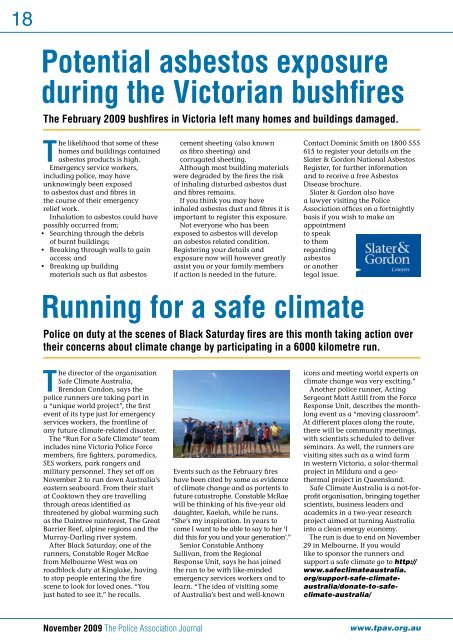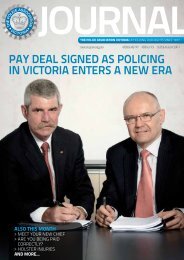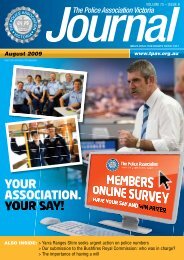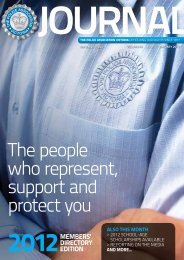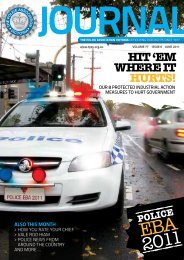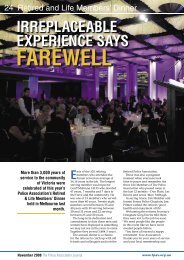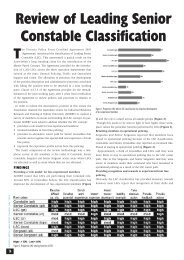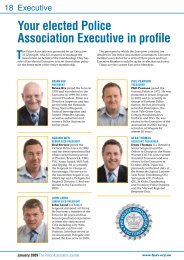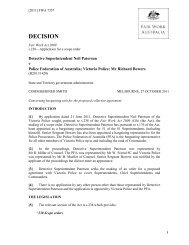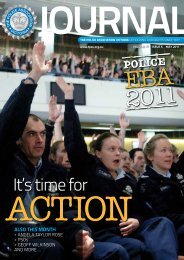The Police Association Journal november 2009
The Police Association Journal november 2009
The Police Association Journal november 2009
You also want an ePaper? Increase the reach of your titles
YUMPU automatically turns print PDFs into web optimized ePapers that Google loves.
18<br />
Potential asbestos exposure<br />
during the Victorian bushfires<br />
<strong>The</strong> February <strong>2009</strong> bushfires in Victoria left many homes and buildings damaged.<br />
<strong>The</strong> likelihood that some of these<br />
homes and buildings contained<br />
asbestos products is high.<br />
Emergency service workers,<br />
including police, may have<br />
unknowingly been exposed<br />
to asbestos dust and fibres in<br />
the course of their emergency<br />
relief work.<br />
Inhalation to asbestos could have<br />
possibly occurred from;<br />
• Searching through the debris<br />
of burnt buildings;<br />
• Breaking through walls to gain<br />
access; and<br />
• Breaking up building<br />
materials such as flat asbestos<br />
cement sheeting (also known<br />
as fibro sheeting) and<br />
corrugated sheeting.<br />
Although most building materials<br />
were degraded by the fires the risk<br />
of inhaling disturbed asbestos dust<br />
and fibres remains.<br />
If you think you may have<br />
inhaled asbestos dust and fibres it is<br />
important to register this exposure.<br />
Not everyone who has been<br />
exposed to asbestos will develop<br />
an asbestos related condition.<br />
Registering your details and<br />
exposure now will however greatly<br />
assist you or your family members<br />
if action is needed in the future.<br />
Contact Dominic Smith on 1800 555<br />
615 to register your details on the<br />
Slater & Gordon National Asbestos<br />
Register, for further information<br />
and to receive a free Asbestos<br />
Disease brochure.<br />
Slater & Gordon also have<br />
a lawyer visiting the <strong>Police</strong><br />
<strong>Association</strong> offices on a fortnightly<br />
basis if you wish to make an<br />
appointment<br />
to speak<br />
to them<br />
regarding<br />
asbestos<br />
or another<br />
legal issue.<br />
Running for a safe climate<br />
<strong>Police</strong> on duty at the scenes of Black Saturday fires are this month taking action over<br />
their concerns about climate change by participating in a 6000 kilometre run.<br />
<strong>The</strong> director of the organisation<br />
Safe Climate Australia,<br />
Brendan Condon, says the<br />
police runners are taking part in<br />
a “unique world project”, the first<br />
event of its type just for emergency<br />
services workers, the frontline of<br />
any future climate-related disaster.<br />
<strong>The</strong> “Run For a Safe Climate” team<br />
includes nine Victoria <strong>Police</strong> Force<br />
members, fire fighters, paramedics,<br />
SES workers, park rangers and<br />
military personnel. <strong>The</strong>y set off on<br />
November 2 to run down Australia’s<br />
eastern seaboard. From their start<br />
at Cooktown they are travelling<br />
through areas identified as<br />
threatened by global warming such<br />
as the Daintree rainforest, <strong>The</strong> Great<br />
Barrier Reef, alpine regions and the<br />
Murray-Darling river system.<br />
After Black Saturday, one of the<br />
runners, Constable Roger McRae<br />
from Melbourne West was on<br />
roadblock duty at Kinglake, having<br />
to stop people entering the fire<br />
scene to look for loved ones. “You<br />
just hated to see it,” he recalls.<br />
Events such as the February fires<br />
have been cited by some as evidence<br />
of climate change and as portents to<br />
future catastrophe. Constable McRae<br />
will be thinking of his five-year old<br />
daughter, Kaelah, while he runs.<br />
“She’s my inspiration. In years to<br />
come I want to be able to say to her ‘I<br />
did this for you and your generation’.”<br />
Senior Constable Anthony<br />
Sullivan, from the Regional<br />
Response Unit, says he has joined<br />
the run to be with like-minded<br />
emergency services workers and to<br />
learn. “<strong>The</strong> idea of visiting some<br />
of Australia’s best and well-known<br />
icons and meeting world experts on<br />
climate change was very exciting.”<br />
Another police runner, Acting<br />
Sergeant Matt Astill from the Force<br />
Response Unit, describes the monthlong<br />
event as a “moving classroom”.<br />
At different places along the route,<br />
there will be community meetings,<br />
with scientists scheduled to deliver<br />
seminars. As well, the runners are<br />
visiting sites such as a wind farm<br />
in western Victoria, a solar-thermal<br />
project in Mildura and a geothermal<br />
project in Queensland.<br />
Safe Climate Australia is a not-forprofit<br />
organisation, bringing together<br />
scientists, business leaders and<br />
academics in a two-year research<br />
project aimed at turning Australia<br />
into a clean energy economy.<br />
<strong>The</strong> run is due to end on November<br />
29 in Melbourne. If you would<br />
like to sponsor the runners and<br />
support a safe climate go to http://<br />
www.safeclimateaustralia.<br />
org/support-safe-climateaustralia/donate-to-safeclimate-australia/<br />
November <strong>2009</strong> <strong>The</strong> <strong>Police</strong> <strong>Association</strong> <strong>Journal</strong><br />
www.tpav.org.au


